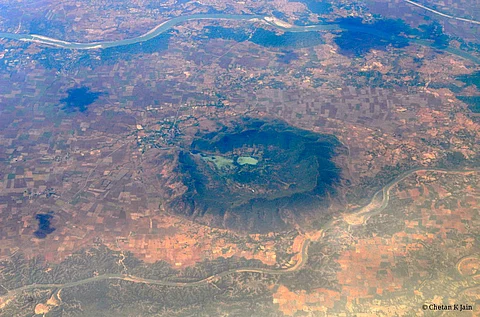
- Destinations
- Experiences
- Stay
- What's new
- Celebrating People
- Responsible Tourism
- CampaignsCampaigns
- SubscribeSubscribe
- Buy Now

Located in the heart of Rajasthan's Baran district, the Ramgarh Crater is a testament to the Earth's dynamic history and India's rich cultural tapestry. Formed approximately 600 million years ago by a meteorite impact, this 3.5 km wide crater is one of only three confirmed impact craters in India, alongside the Lonar Crater in Maharashtra and the Dhala Crater in Madhya Pradesh.
The Ramgarh Crater's significance extends beyond its formation. Scientific studies have revealed higher-than-normal concentrations of iron, nickel, and cobalt within the crater, elements commonly associated with meteorites. Recognising its geological importance, the crater has been designated as India's first notified geo-heritage site, highlighting its value for both scientific research and tourism.
At the heart of the crater lies the Bhand Deva Temple, a 10th-century Shiva temple renowned for its intricate Nagara-style architecture reminiscent of the Khajuraho temples, earning it the moniker "Mini Khajuraho". Perched on the crater's banks, this temple serves as a place of worship and a symbol of the harmonious mix of natural and cultural heritage.
Despite its location in the arid landscapes of Rajasthan, the Ramgarh Crater fosters a microclimate that supports diverse flora and fauna. The crater houses two lakes, including the Pushkar Talab, which has been notified as a wetland under the Wetland (Conservation & Management) Rules, 2017. These water bodies attract migratory birds and support wildlife such as chital deer and wild boars, making it a haven for nature enthusiasts.
Recognising the crater's potential as a tourist destination, the Rajasthan government has reportedly initiated an INR 57.22 crore development project to enhance the visitor experience. Planned developments include:
Construction of high-quality access roads and nature trails
Establishment of an information center and knowledge hub
Beautification of the crater lake with the addition of a jetty
Development of gardens and green areas
Installation of a ropeway to facilitate access to the temple
These initiatives aim to boost eco-tourism while preserving the site's ecological and cultural integrity.
Located approximately 44 km north of Baran city, the Ramgarh Crater is accessible via well-connected roads. The best time to visit is during the cooler months, from October to March when the weather is pleasant.
